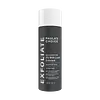What's inside
What's inside
 Key Ingredients
Key Ingredients

No key ingredients
 Benefits
Benefits

 Concerns
Concerns

 Ingredients Side-by-side
Ingredients Side-by-side

Water
Skin ConditioningMelaleuca Alternifolia Leaf Water 20%
AntimicrobialPropanediol
Solvent1,2-Hexanediol
Skin ConditioningNiacinamide
SmoothingC12-14 Pareth-12
EmulsifyingBetaine
HumectantPolyglyceryl-4 Caprate
EmulsifyingAllantoin
Skin ConditioningDecyl Glucoside
CleansingEthylhexylglycerin
Skin ConditioningDipotassium Glycyrrhizate
HumectantRosmarinus Officinalis Leaf Oil
MaskingDisodium EDTA
Sodium Hyaluronate
HumectantSalix Alba Bark Extract
AstringentHyaluronic Acid
HumectantCapryloyl Salicylic Acid
ExfoliatingSalicylic Acid
MaskingTromethamine
BufferingGluconolactone
Skin ConditioningCitric Acid
BufferingSea Water
HumectantLactobacillus Ferment
Skin ConditioningGlyceryl Glucoside
HumectantGlycerin
HumectantHibiscus Sabdariffa Flower Extract
Skin ConditioningDipropylene Glycol
HumectantButylene Glycol
HumectantHydrogenated Lecithin
EmulsifyingPolyglyceryl-10 Oleate
Skin ConditioningPanthenol
Skin ConditioningAsiaticoside
AntioxidantGlucose
HumectantCetearyl Alcohol
EmollientSorbitan Stearate
EmulsifyingGlyceryl Stearate
EmollientMadecassic Acid
Skin ConditioningAsiatic Acid
Skin ConditioningCeramide NP
Skin ConditioningSalvia Officinalis Leaf Extract
CleansingOriganum Majorana Leaf Extract
AntiseborrhoeicOcimum Basilicum Leaf Extract
Skin ConditioningPortulaca Oleracea Extract
Skin ConditioningCentella Asiatica Extract
CleansingArtemisia Capillaris Extract
Madecassoside
AntioxidantGlycine
BufferingSerine
MaskingGlutamic Acid
HumectantAspartic Acid
MaskingLeucine
Skin ConditioningAlanine
MaskingLysine
Skin ConditioningArginine
MaskingTyrosine
MaskingPhenylalanine
MaskingValine
MaskingThreonine
Proline
Skin ConditioningIsoleucine
Skin ConditioningHistidine
HumectantMethionine
Skin ConditioningCysteine
AntioxidantWater, Melaleuca Alternifolia Leaf Water 20%, Propanediol, 1,2-Hexanediol, Niacinamide, C12-14 Pareth-12, Betaine, Polyglyceryl-4 Caprate, Allantoin, Decyl Glucoside, Ethylhexylglycerin, Dipotassium Glycyrrhizate, Rosmarinus Officinalis Leaf Oil, Disodium EDTA, Sodium Hyaluronate, Salix Alba Bark Extract, Hyaluronic Acid, Capryloyl Salicylic Acid, Salicylic Acid, Tromethamine, Gluconolactone, Citric Acid, Sea Water, Lactobacillus Ferment, Glyceryl Glucoside, Glycerin, Hibiscus Sabdariffa Flower Extract, Dipropylene Glycol, Butylene Glycol, Hydrogenated Lecithin, Polyglyceryl-10 Oleate, Panthenol, Asiaticoside, Glucose, Cetearyl Alcohol, Sorbitan Stearate, Glyceryl Stearate, Madecassic Acid, Asiatic Acid, Ceramide NP, Salvia Officinalis Leaf Extract, Origanum Majorana Leaf Extract, Ocimum Basilicum Leaf Extract, Portulaca Oleracea Extract, Centella Asiatica Extract, Artemisia Capillaris Extract, Madecassoside, Glycine, Serine, Glutamic Acid, Aspartic Acid, Leucine, Alanine, Lysine, Arginine, Tyrosine, Phenylalanine, Valine, Threonine, Proline, Isoleucine, Histidine, Methionine, Cysteine
 Reviews
Reviews

Ingredients Explained
These ingredients are found in both products.
Ingredients higher up in an ingredient list are typically present in a larger amount.
Butylene Glycol (or BG) is used within cosmetic products for a few different reasons:
Overall, Butylene Glycol is a safe and well-rounded ingredient that works well with other ingredients.
Though this ingredient works well with most skin types, some people with sensitive skin may experience a reaction such as allergic rashes, closed comedones, or itchiness.
Learn more about Butylene GlycolSalicylic Acid (also known as beta hydroxy acid or BHA) is a well-known ingredient for treating skin that struggles with acne and clogged pores. It exfoliates both the skin's surface and deep within the pores to help clear out buildup, control oil, and reduce inflammation.
Unlike AHAs (alpha hydroxy acids), salicylic acid is oil-soluble. This allows it to penetrate into pores which makes it especially effective for treating blackheads and preventing future breakouts.
Salicylic acid is also known for its soothing properties. It has a similar structure to aspirin and can calm inflamed or irritated skin, making it a good option for acne-prone skin that is also sensitive.
Concentrations of 0.5-2% are recognized by the U.S. FDA as an over-the-counter topical acne product.
It can cause irritation and/or dryness if one's skin already has a compromised moisture barrier, so it's best to focus on repairing that before introducing this ingredient into your routine.
While salicylic acid does not increase sun sensitivity, it’s still important to wear sunscreen daily to protect your skin.
If you are looking for the ingredient called BHA or Butylated Hydroxyanisole, click here.
Learn more about Salicylic AcidWater. It's the most common cosmetic ingredient of all. You'll usually see it at the top of ingredient lists, meaning that it makes up the largest part of the product.
So why is it so popular? Water most often acts as a solvent - this means that it helps dissolve other ingredients into the formulation.
You'll also recognize water as that liquid we all need to stay alive. If you see this, drink a glass of water. Stay hydrated!
Learn more about Water